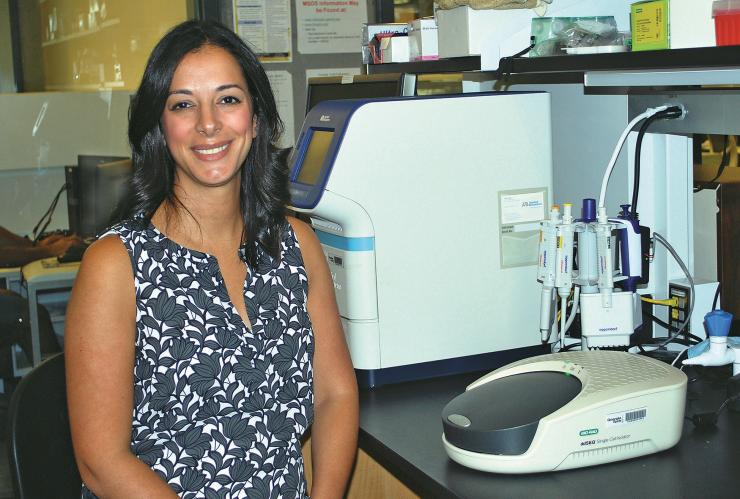Advances in technology have driven the evolution of genome analysis and collaborative research forward at a rapid rate. This is particularly evident within the Petit Institute for Bioengineering and Bioeciences at the Georgia Institute of Technology, where the Genome Analysis Core has added a powerful new tool that allows researchers to look deeper into the gene expression analysis on a single cell level.
“Since we launched in 2012, the core has evolved quite a bit,” says Dalia Arafat-Gulick, who manages the lab of Petit Institute researcher Greg Gibson (professor in the School of Biological Sciences) and the Genome Analysis Core (contained within the Gibson lab space), in the Krone Engineered Biosystems Building. “The usage and diversity of equipment has definitely increased since then, and so have the services we provide.”
It all started with the Fluidigm Biomark quantitative real-time PCR (polymerase chain reaction). PCR, sometimes called “molecular photocopying,” is a fast technique to amplify small segments of DNA. The PCR technique was invented more than 30 years ago and it has transformed the study of DNA – mapping in the Human Genome Project.
PCR can be inexpensive if you’re only looking at a few genes, according to Gibson. “The costs can add up quickly,” he says. “But the Fluidigm platform brings the costs down further.”
This makes it possible, for example, to monitor the expression of 96 genes in 96 samples for around $1,000 (or 10 cents per reaction), “with high accuracy,” Gibson adds.
The latest transformative tool in Georgia Tech’s Genome Analysis Core is the ddSEQ, part of the single-cell sequencing system co-developed by Illumina and Bio-Rad. The Marcus Foundation collaborated with the Petit Institute in providing funding support, as Georgia Tech last April became the first research institution in the Southeast to deploy the ddSEQ.
“The ddSEQ is essentially a sample preparation platform,” explains Steve Woodard, director of core facilities for the Petit Institute. “You’re preparing samples to go downstream for sequencing in the Molecular Evolution Core or the High-Throughput DNA Sequencing Core. Just another example of how our core facilities are integrated.”
The process typically begins upstream in the Cellular Analysis and Cytometry Core, where researchers will utilize flow cytometry to isolate specific cell populations. Then the ddSEQ separates those cells into a sub-nanoliter oil based droplets on a disposable cartridge, in under five minutes, “which gives you a fast turnaround for each cell captured,” Arafat-Gulick says.
Each cartridge can accommodate up to four samples, which allows each sample to be processed simultaneously. Cell lysis, reverse transcription, and bar-coding occur inside the individual droplets, which allow researchers to amplify several thousand transcripts in each cell.
“The next step is to actually get them sequenced,” Arafat-Gulick says. “That’s where the downstream cores [High Throughput and Molecular Evolution] come in. They have the equipment that allows us to ultimately analyze the gene expression levels of these cells.”
In this way, researchers can peek inside hundreds – or even thousands – of cells, seeing how much diversity in the mixture there is, or monitoring how individual cells are responding to treatments, all for around $10 a cell. The technology also exists to sequence the DNA, and measure methylation states of genes, “which is transforming genomic analysis,” Gibson says.
“The next step is to actually get them sequenced,” Arafat-Gulick says. “That’s where the downstream cores [High Throughput and Molecular Evolution] come in. They have the equipment that allows us to ultimately analyze the gene expression levels of these cells.”
A number of Petit Institute researchers, including Krish Roy, Ed Botchwey, and Gibson, are working in the single-cell arena now, utilizing the equipment, techniques, and services available through the Genome Analysis Core.
“It’s a quantitative way to look at RNA sequencing on a single cellular level,” Arafat-Gulick says. “Principal investigators really want to see what’s happening on a cell to cell basis, and this new technology makes this accessible, at a much faster rate than before.”
•••
The Petit Institute's state-of-the-art research facilities, known as "Core Facilities," serve as a shared resource for the bioengineering and bioscience community. Consultation, training, and technical support is available for a variety of research projects. Users have access to over 100 pieces of lab equipment totaling over $24 million.
Learn more about the Petit Institute’s core facilities and how they can support your research projects.
CONTACT:
Jerry Grillo
Communications Officer II
Parker H. Petit Institute for
Bioengineering and Bioscience

Jerry GrilloCommunications Officer IIParker H. Petit Institute forBioengineering and Bioscience
